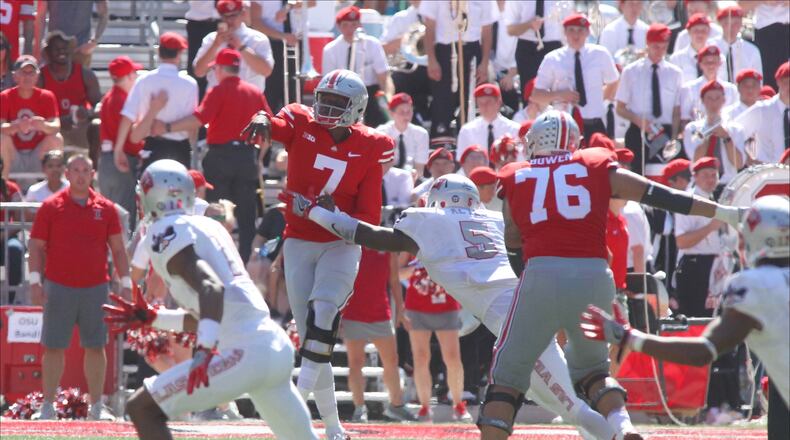That was the overall takeaway from offensive coordinator Kevin Wilson’s meeting with reporters this week.
Well, let’s amend that opening line a bit — look for the 2018 Ohio State offense to be an evolved version of Meyer’s original spread-option attack.
At least that’s the plan.
“The offense in my opinion, we’re moving and growing — it’s not changing,” said Wilson, whose offense at Northwestern nearly 20 years ago influenced the development of Meyer’s strategy in the first place. "There’s not new terminology. There’s not a lot of new plays. You emphasize, which is something I’ve always been a part of, what players can do.”
That goes for the left tackle, tight end, center, receivers and runnings backs.
Oh yeah, the quarterback, too.
The signal caller is of course the part that everyone is most curious about these days since J.T. Barrett is out of eligibility.
RELATED: The curious case of J.T. Barrett and the NFL draft
The fact none of the three candidates to replace him — Dwayne Haskins Jr., Joe Burrow and Tate Martell — have quite the same skill set has caused some consternation, at least on the outside.
Wilson seemed to have exactly zero concerns about that.
Whether the No. 1 quarterback is the strong-armed Haskins, the scrambler Tate or Burrow, who is more or less a mix of the two, the overall structure of the attack will be the same.
They’ll all throw the ball, they’ll all run the ball, and they’ll all be asked to read (a.k.a. option) defenders frequently, too.
"Are you reading the end and (the quarterback is) pulling it (and running), or are you blocking and reading a secondary level player where it's more of an RPO (run-pass option)?" Wilson said. "It's still the same offense, but the read has changed based on the strength of the quarterback. That's why to me I never thought it was that big of a deal because it's subtle tweaks that give the skill guys a chance."
RELATED: What is an RPO?
Wilson’s confidence it will all come together comes from a couple of different places.
Leading off, Meyer has done a great job stocking his offense with talented players who possess and in many cases have already shown star potential. There are multiple known quantities at receiver and two 1,000-yard running backs, though a couple of holes must be filled on the offensive line.
Beyond that, Wilson has already proven he knows how to construct an offense around multiple casts of characters with different sets of skills whether he was at Miami University, Northwestern, Oklahoma or Indiana.
Surly Urban Meyer is a good Urban Meyer, at least this time of year https://t.co/Kgp4A8JMPJ pic.twitter.com/JVVnAWl8Bh
— daytonsports (@daytonsports) March 28, 2018
Conveniently enough, Wilson’s 2015 Indiana offense that led the Big Ten in passing, total offense and scoring had personnel that strongly resembles what the 2018 Buckeyes figure to look like if Haskins wins the starting job.
That season Nate Sudfeld was a strong-armed pocket passer like Haskins who excelled at distributing the ball to a large cast of characters playing behind a strong offensive line.
“The quarterback there wasn’t a very good runner so we had two kids that ran for 1,000 yards because those carries went to the second tailback, OK?” Wilson said. “And then all of a sudden instead of the quarterback keeping it and running it, he was pulling and throwing. That’s why you had three receivers with over 50 catches. But it was still inside zone, ‘power,’ the ‘G’ (running) play. It was the same plays, but where the ball got distributed (was different).
“As we go, the offense isn’t changing. We’re going to develop what we’ve got, and then those quarterbacks — in time we put it together. Is it read? Is it run? You better be able to do a little bit of both.”
Personnel is rarely a problem at Ohio State, especially over the last four seasons.
But putting everyone in the best position to succeed has been a struggle over the past three, something that carried over from the failed Ed Warinner/Tim Beck offensive experiment to the combination of Wilson and Ryan Day last season.
The Buckeyes put up big numbers most weeks, but the offense broke down at key junctures, too.
“Last year you were kind of jockeying and feeling things out, and at the end of the day, you’re trying to give Coach Meyer what he wants because he’s the head coach,” Wilson said.
Although Day was given a new contract and the “co” was dropped from his offensive coordinator title this year, not much has changed in terms of who does what for the offense.
While making sure no one took for granted winning a Big Ten title and winning a bowl game (not to mention beating Michigan) last season, Wilson acknowledged there is room for improvement any time a team doesn’t go undefeated.
How will that be achieved?
This year’s quarterback will like last year’s quarterback get to decide who gets the ball, but he might be less likely to call his own number — be that because he is a better passer than Barrett or less of a runner.
RELATED: Ohio State football and the myserious disappearing tailback runs
Wilson didn’t say it, but lacking the crutch of the quarterback running the ball a dozen times or more could force the offense to be more dynamic if it means more players with more speed and playmaking ability are touching the ball more often.
“There are going to be reads in the run game because the box is always going to be overloaded. So the reads are him running it or him taking it and throwing it,” Wilson said.
“So there’s gonna be reads and based on the situation there might be some situations where -- I don’t care who the quarterback is -- he is going to have to read it and pull the ball. Period. No matter who the quarterback is, there are going to be situations where he’s going to have to throw the football. No matter who the quarterback is, at the end of the day you emphasize the quarterback’s talents, running skill sets, throwing skill sets as he makes reads.
“And it’s going to be a great offense.”
About the Author

